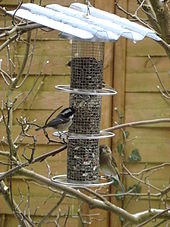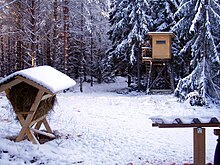Winter feeding
Under winter feeding means the feeding of animals in the winter . In the case of farm animals, winter feeding often no longer differs from feeding in summer ; Only in beekeeping is there special winter feeding to compensate for the honey removed, whereby the choice of words is slightly misleading, because the feeding itself takes place here in autumn. In the case of wild animals, winter feeding specifically means the giving of food by humans in winter. This includes both the filling of the feeding places in the forest by the hunter and the private supply of bird food, for example in the form of grain mixtures in birdhouses .
Feeding birds
Feeding birds in average cold winters is controversial. Critics object that it disturbs the ecological balance and natural selection : only a few, frequent species of resident bird benefit from the usual type of feeding and the migratory birds, weakened by their long journey, encounter artificially increased competition in spring and have to move around the limited territories and Dispute breeding grounds. In addition, there is a risk of pathogens spreading with improper feeding. Nature conservation organizations therefore usually advise feeding only when there is persistent frost and a closed snow cover.
- See also: Adapted year-round feeding
Feeding game
The game feeding results as a commitment of the hunting entitled under the obligation Hege one hand in BJagdG § 1 (Example Winter gate and Wildschaden ), on the other hand, in fulfillment of the hunting protection from BJagdG §23. It serves as a substitute for conservation-giving food that does not occur in nature or is no longer in sufficient quantities. The time of administration depends on the statements in the hunting laws of the countries. Emergency time does not automatically correspond to winter time.
During the time of need, the game has too little grazing (food) and is dependent on artificial sources of food. Times of need are stipulated by law in the hunting laws of the federal states with very different provisions. An emergency period can exist for a specified period of time or it can be determined by appropriate bodies in the event of a high or frozen snow cover, frost, drought or flooding. Nowadays, food shortages must also be taken into account, which arise depending on the land and soil use and can differ in their location and time. Large-scale agriculture can result in a real harvest shock.
Chamois and ibex are generally not fed due to their habitat. However, if these animals are in need, it can be assumed that they will seek feeding points for other hoofed game such as red deer or roe deer .
During the feeding of game, there is a federal law prohibition to kill hoofed game within a radius of 200 m from the feeding places. Artificially created feeding stations that are stocked with species-appropriate feed serve to preserve the game.
Measures to improve grazing (e.g. wild fields, wild meadows or prosswood areas) do not count as feeding. Kirrungen , Luder courts or Ablenkfütterungen are no feedings in terms of nutrition. They are used to guide the game for the purpose of hunting or damage prevention. Their properties as feed are assessed differently in the absence of state regulations. No slaughterhouse waste, only game waste, may be brought to play areas for the red fox . Slut places are considered feeding places. Game may be shot at feeding stations during the permitted hunting season .
According to the BJagdG , the federal states can prohibit the feeding of game or make it dependent on a permit.
In Bavaria there are no state-wide regulations due to the different landscapes. Rather, the hunting authority issues regulations on a case-by-case basis to prevent improper feeding of wild animals, e.g. B. with regard to non-species-appropriate feed, feeding outside of the emergency time with the exception of distraction feeding for wild boar, feeding in protective forests, if this affects their protective function etc.
The feeding takes place by means of a feeding trough, feeding table or automatic feeder / slide feeding for pellets (hoofed game, wild boar, rabbits), automatic feeder or pheasant chutes with grain and maize, or feed lanes (free passage in cover, which is 0.5 m long per pheasant) and partridge chutes that are laid out away from trees, as the partridges are otherwise hunted by birds of prey. When feeding ducks (corn, grain, acorns), the feed must not get into the water (Section 26 of the Water Resources Act).
Feed is in natural feed such as acorns, chestnuts, beechnuts, oats, corn and the like. a. Grain, as well as industrially manufactured, such as soy meal, sesame cake, alfalfa flour, wheat germ, brewer's grains or pressed concentrates (pellets). Dry food contains less than 10% moisture. Juice feed consists of silage, beets, potatoes, fruit, vegetables, cabbage, pomace or juice feed mixtures.
Feeding places are set up in such a way that hoofed game (e.g. roe deer) do not have to run through harsh snow to avoid injuring themselves.
In the discussion about the legal implementation of game feeding, hunters such as B. the hunter Otto lattice argued in a Tyrolean mountain area with the lack of autumn and winter clearing. The demands of some wildlife biologists for wild game and the omission of any feeding, they counter that the game would be degraded to pests and without feeding in the Tyrolean mountain regions enormous losses can be expected. Some animals stayed alive, but far too few to be able to speak of healthy populations. In addition, they consider feeding to be a basic requirement for preventing game damage and a prerequisite for the well-being and good general condition of the game. In her opinion, a lack of feeding leads to poor physical condition, but good development is a yardstick for successful care.
The feed used includes mountain hay, silage and a concentrated feed mixture consisting of 40% broken corn, 40% non-crushed oats and 20% sesame. Opponents of feeding criticize concentrates, in particular, for the fact that a low-fiber, high-energy diet forces the game to increasingly bite or peel trees in order to absorb the fibers required for digestion. The Office for Forests, Nature and Landscape of the Principality of Liechtenstein also considers feeding outside of designated emergency times to be counterproductive, and criticizes the fact that hunters only want to bring through the winter those selected animal species that they are interested in in the form of trophies .
The occurrence of game at the feeding stations helps to determine the population, and the feed consumption is a good basis for estimating the game population, with roe deer consuming ½ kg of feed per day and per day.
literature
- Peter Berthold , Gabriele Mohr: Feeding birds - the right way. Attract, protect, determine safely. Kosmos, Stuttgart 2006, 79 pages, ISBN 3-440-10800-7
- Hunting lexicon . blv, 1996
- Ilse Haseder , Gerhard Stinglwagner : Knaurs Großes Jagdlexikon , Augsburg 2000, ISBN 3-8289-1579-5
- Otto Henze (welcomed), Johann Gepp: Bird nest boxes in the garden and forest. About the way of life and importance of all its residents. A non-fiction and control book. 6th edition, Leopold Stocker Verlag , Graz u. Stuttgart 2004
- Julia Numßen : Handbook hunter language, all technical terms from A - Z compactly explained , Munich 2017, ISBN 978-3-8354-1728-1
Individual evidence
- ↑ § 1 (2) 2: "The maintenance must be carried out in such a way that impairment of proper agricultural, forestry and fishing use, in particular damage to game, is avoided as far as possible."
- ↑ https://www.gesetze-im-internet.de/bjagdg/__23.html
- ↑ Haseder, p. 912.
- ↑ http://www.oejv-hessen.de/PDF/Hess.JAGDVERORDNUNG-10.12.2015.pdf
- ↑ § 30 HJagdG (5): - Wildlife feeding: There is an emergency when there is a deficit between the current need for food and the natural food supply. This is usually the case if the otherwise existing natural grazing area is missing as a result of the weather (e.g. high levels of snow, harsh snow, icing, longer periods of frost or drought) or as a result of natural disasters (e.g. floods, forest fires) . ... In hunting districts in which the hunting authorities have determined an emergency time for ruminating hoofed game, hunting ruminating hoofed game is prohibited, as well as: § 45 HJagdV - determination of an emergency time.
- ↑ Numßen, p. 45
- ↑ The animals usually find enough food in winter's fridge , Barbara Zweifel-Schielly, Glarnerland Nature Center.
- ↑ Emergency feeding concept within the meaning of Art. 14 of the Hegeverordnung, LBGl. 2003 No. 198 and as a clarification of point 16 of the hunting lease conditions for the hunting lease period 2004-2012. (PDF) , Office of Forests, Nature and Landscape - National Administration Liechtenstein .
Web links
- Naturschutzbund Deutschland - feeding birds in winter
- Naturschutzbund Deutschland - Winter feeding: the pros and cons
- State Association for Bird Protection in Bavaria: Practical tips on feeding birds
- Wildvogelhilfe.org - bird feeding in winter



